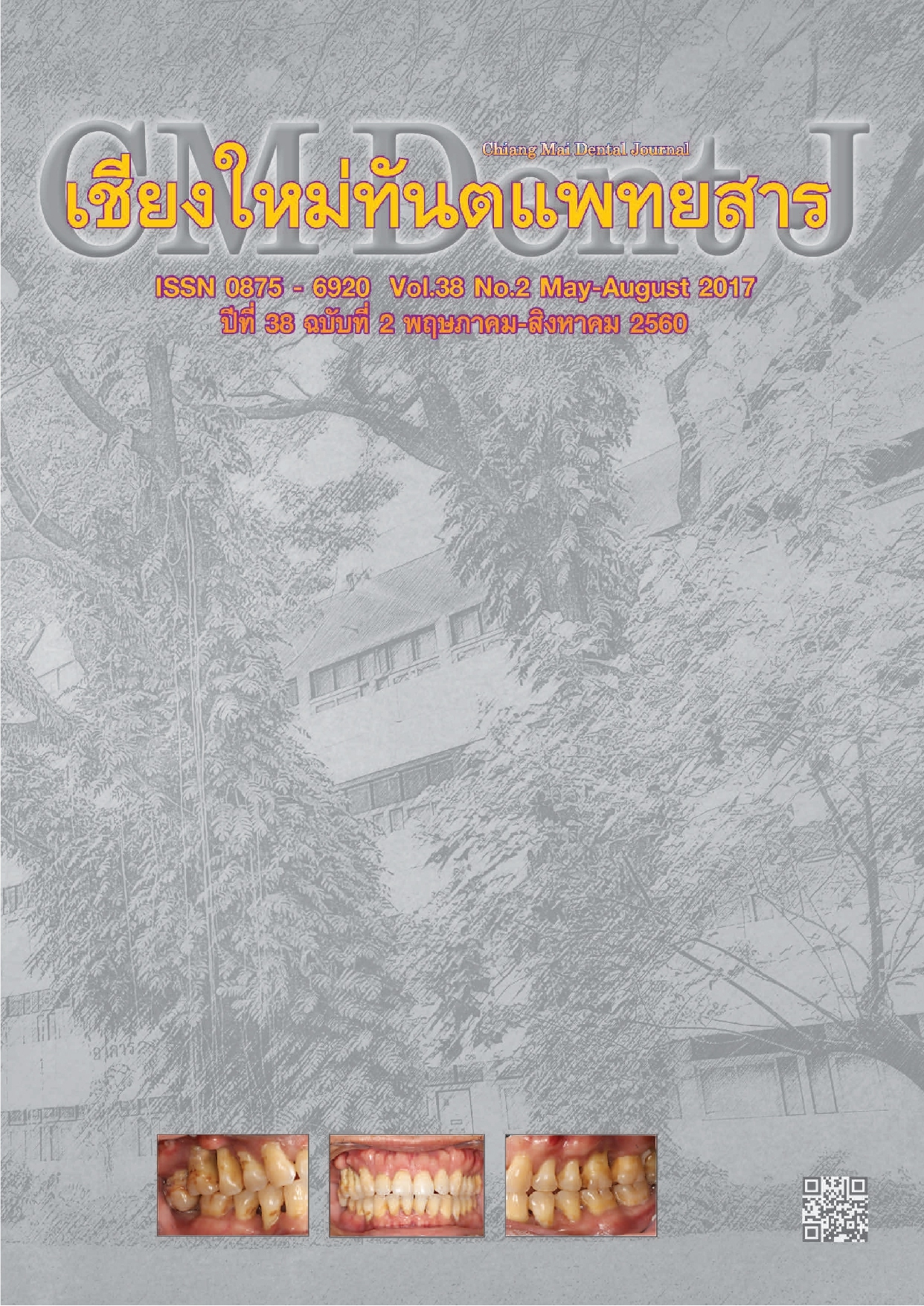Influencing Factors on Initial Management of Cleft Lip and Palate Patients by Dentists after Training Workshop
Main Article Content
Abstract
The purpose of this descriptive research was to study influencing factors on initial management of cleft lip and palate patients by dentists after training workshop using questionnaires and individual interviews from 65 dentists. All numeric data was analyzed with SPSS program. The results showed that the first factor was the dentist factor which was related to their knowledge, advice from experts, experience, and participation in the workshop. The second factor was the environmental factor which consisted of hospital management system, potency of interdisciplinary team, available equipment, and supporting projects. Moreover, the results indicated that participation in the workshop was a factor improving dentist efficiency for initial management of cleft lip and palate patients
Article Details
References
Chaiworawitkul M. Incidence, etiology and prevention of cleft lip and/or palate. CM Dent J 2012; 33: 45-55 (in Thai)
Clarren SK, Anderson B, Wolf LS. Feeding infants with cleft lip, cleft palate, or cleft lip and palate. Cleft Palate J 1987; 24: 244-249.
Masarei AG, Sell D, Habel A, Mars M, Sommerlad BC, Wade A. The nature of feeding in infants with unrepaired cleft lip and/or palate compared with healthy noncleft infants. Cleft Palate Craniofac J 2007; 44: 321-328.
Koltz PF, Albino FP, Hyatt B, Fargione RA, Katzel E, Girotto JA. Incidence of use of acid suppression medications in infants with oral clefting. Cleft Palate Craniofac J 2010; 47: 530-533.
Thomas SD, Elizabeth JS, Harshita P. Overcoming feeding issues in children with orofacial clefts: A review. Int J Curr Res Aca Rev 2015; 3: 300-308.
Miller CK, Madhoun LL. Feeding and swallowing issues in infants with craniofacial anomalies. Perspectives of the ASHA Special Interest Group 2016; 1 (SIG 5): 13-26.
Thanaviratananit S. Ears Nose and Throat Problems in cleft palate. Srinagarind Med J 2001; 16: 37-41.
Prathanee B. Speech and Language Problems in cleft palate. Srinagarind Med J 2001; 16: 8-26.
Kummer AW, Clark SL, Redle EE, Thomsen LL, Billmire DA. Current practice in assessing and reporting speech outcomes of cleft palate and velopharyngeal surgery: A survey of cleft palate/craniofacial professionals. Cleft Palate Craniofac J 2012; 49: 146-152.
Turner SR, Thomas PWN, Dowell T, Rumsey N, Sandy JR. Psychological outcomes amongst cleft patients and their families. Brit J Plast Surg 1997; 50: 1-9.
Sousa A, Devare S, Ghanshani J. Psychological issues in cleft lip and cleft palate. J Indian Assoc Pediatr Surg 2009; 14: 55-58.
Millar K, Bell A, Bowman A, Brown D, Lo T-W, Siebert P, Simmons D, Ayoub A. Psychological status as a function of residual scarring and facial asymmetry after surgical repair of cleft lip and palate. Cleft Palate Craniofac J 2013; 50:150-157.
American Cleft Palate-Craniofacial Association; Parameter for evaluating and Treatment of Patient, 2009. Available from: http:// www.acpa-cpf.org/uploads/site/Parameters_Rev_2009.pdf
Molsted K. Treatment outcome in cleft lip and palate: issues and perspectives. Crit Rev Oral Biol Med 1999; 10: 225-39.
Chaiworawitkul M. Interdisciplinary treatment in cleft patients. In: Chaiworawitkul M, ed: Comprehensive Cleft Care for Dentists and Orthodontists, Vol I. Chiang Mai: Trio Advertising and Media; 2012: 55-68.
Chaiworawitkul M. Survey of initial management for cleft lip and palate patients by primary dentists in the upper north of Thailand. CM Dent J 2011; 32: 77-84 (in Thai)
Rivkin CJ, Keith O, Crawford PJM, Hathorn IS. Dental care for the patient with a cleft lip and palate. Part 1: From birth to the mixed dentition stage. Br Dent J 2000; 188: 78 – 83.
Precious DS, Goodday RH, Morrison AD, Davis BR. Cleft lip and palate: A review for dentists. J Can Dent Assoc 2001; 67: 668-73.
Freitas JA, Neves LT, Almeida AL, Garib DG, Trindade-Suedam IK, Yaedú RY, Carvalho Lauris RC, Soares S, Oliveira TM, João Henrique Nogueira Pinto JH. Rehabilitative treatment of cleft lip and palate: Experience of the Hospital for Rehabilitation of Craniofacial Anomalies/USP (HRAC/USP) - Part 1: Overall aspects J Appl Oral Sci 2012; 20 Jan./Feb. Available from: http://dx.doi.org/10.1590/S1678-77572012000100003
American Cleft Palate-Craniofacial Association. Parameters for Evaluation and Treatment of Patients with Cleft Lip/Palate or Other Craniofacial Anomalies. Chapel Hill, NC: The Maternal and Child Health Bureau, Health Resources and Services Administration, US Public Health Service, DHHS; November 2009. Grant #MCJ-425074. Available from: http://www.acpa-cpf.org/resources/acpa_publications Accessed June 26, 2012.
American Cleft Palate-Craniofacial Association Commis-sion on Approval of Teams. Standards for Approval of Cleft Palate and Craniofacial Teams. American Cleft Palate-Craniofacial Association; 2010. Available from: http://www.acpa-cpf.org/uploads/site/Standards_2010.pdf Accessed June 26, 2012.


